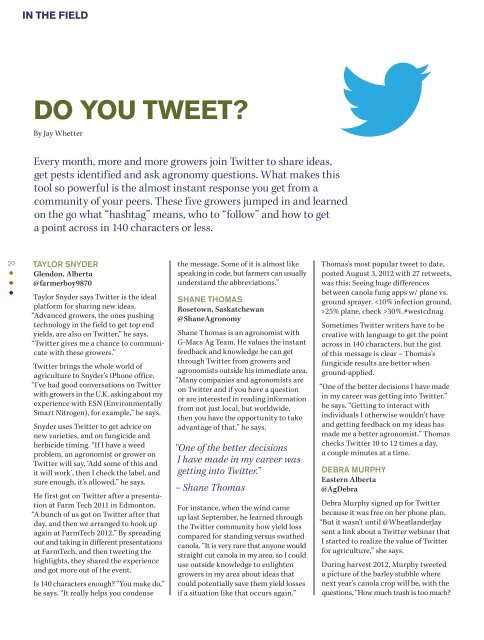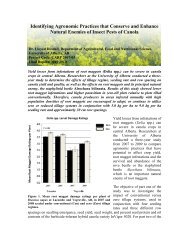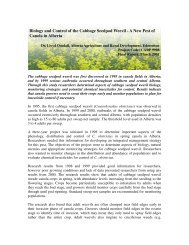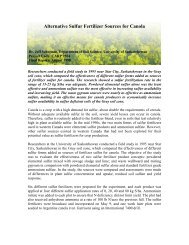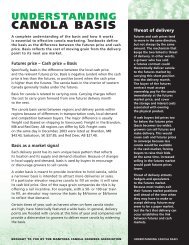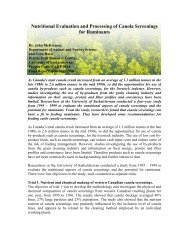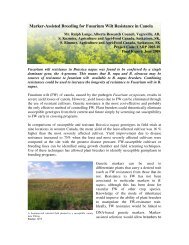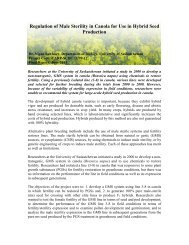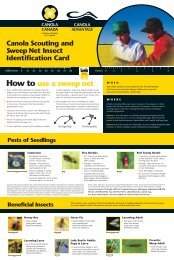Canola Digest, January 2013 - SaskCanola
Canola Digest, January 2013 - SaskCanola
Canola Digest, January 2013 - SaskCanola
You also want an ePaper? Increase the reach of your titles
YUMPU automatically turns print PDFs into web optimized ePapers that Google loves.
IN THE FIELD<br />
DO YOU TWEET?<br />
By Jay Whetter<br />
Every month, more and more growers join Twitter to share ideas,<br />
get pests identified and ask agronomy questions. What makes this<br />
tool so powerful is the almost instant response you get from a<br />
community of your peers. These five growers jumped in and learned<br />
on the go what “hashtag” means, who to “follow” and how to get<br />
a point across in 140 characters or less.<br />
20<br />
TAYLOR SNYDER<br />
Glendon, Alberta<br />
@farmerboy9870<br />
Taylor Snyder says Twitter is the ideal<br />
platform for sharing new ideas.<br />
“Advanced growers, the ones pushing<br />
technology in the field to get top end<br />
yields, are also on Twitter,” he says.<br />
“Twitter gives me a chance to communicate<br />
with these growers.”<br />
Twitter brings the whole world of<br />
agriculture to Snyder’s iPhone office.<br />
“I’ve had good conversations on Twitter<br />
with growers in the U.K. asking about my<br />
experience with ESN (Environmentally<br />
Smart Nitrogen), for example,” he says.<br />
Snyder uses Twitter to get advice on<br />
new varieties, and on fungicide and<br />
herbicide timing. “If I have a weed<br />
problem, an agronomist or grower on<br />
Twitter will say, ‘Add some of this and<br />
it will work’, then I check the label, and<br />
sure enough, it’s allowed,” he says.<br />
He first got on Twitter after a presentation<br />
at Farm Tech 2011 in Edmonton.<br />
“A bunch of us got on Twitter after that<br />
day, and then we arranged to hook up<br />
again at FarmTech 2012.” By spreading<br />
out and taking in different presentations<br />
at FarmTech, and then tweeting the<br />
highlights, they shared the experience<br />
and got more out of the event.<br />
Is 140 characters enough? “You make do,”<br />
he says. “It really helps you condense<br />
the message. Some of it is almost like<br />
speaking in code, but farmers can usually<br />
understand the abbreviations.”<br />
SHANE THOMAS<br />
Rosetown, Saskatchewan<br />
@ShaneAgronomy<br />
Shane Thomas is an agronomist with<br />
G-Macs Ag Team. He values the instant<br />
feedback and knowledge he can get<br />
through Twitter from growers and<br />
agronomists outside his immediate area.<br />
“Many companies and agronomists are<br />
on Twitter and if you have a question<br />
or are interested in reading information<br />
from not just local, but worldwide,<br />
then you have the opportunity to take<br />
advantage of that,” he says.<br />
“One of the better decisions<br />
I have made in my career was<br />
getting into Twitter.”<br />
– Shane Thomas<br />
For instance, when the wind came<br />
up last September, he learned through<br />
the Twitter community how yield loss<br />
compared for standing versus swathed<br />
canola. “It is very rare that anyone would<br />
straight cut canola in my area, so I could<br />
use outside knowledge to enlighten<br />
growers in my area about ideas that<br />
could potentially save them yield losses<br />
if a situation like that occurs again.”<br />
Thomas’s most popular tweet to date,<br />
posted August 3, 2012 with 27 retweets,<br />
was this: Seeing huge differences<br />
between canola fung apps w/ plane vs.<br />
ground sprayer. 25% plane, check >30%.#westcdnag<br />
Sometimes Twitter writers have to be<br />
creative with language to get the point<br />
across in 140 characters, but the gist<br />
of this message is clear – Thomas’s<br />
fungicide results are better when<br />
ground-applied.<br />
“One of the better decisions I have made<br />
in my career was getting into Twitter,”<br />
he says. “Getting to interact with<br />
individuals I otherwise wouldn’t have<br />
and getting feedback on my ideas has<br />
made me a better agronomist.” Thomas<br />
checks Twitter 10 to 12 times a day,<br />
a couple minutes at a time.<br />
DEBRA MURPHY<br />
Eastern Alberta<br />
@AgDebra<br />
Debra Murphy signed up for Twitter<br />
because it was free on her phone plan.<br />
“But it wasn’t until @WheatlanderJay<br />
sent a link about a Twitter webinar that<br />
I started to realize the value of Twitter<br />
for agriculture,” she says.<br />
During harvest 2012, Murphy tweeted<br />
a picture of the barley stubble where<br />
next year’s canola crop will be, with the<br />
questions, “How much trash is too much?


